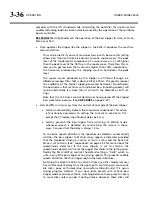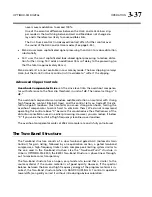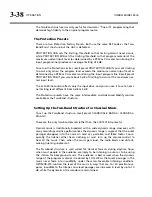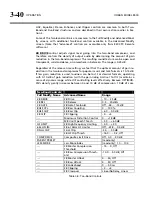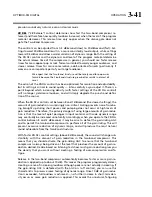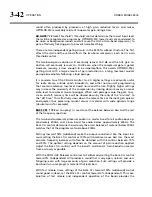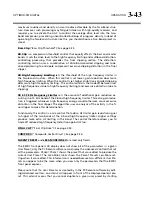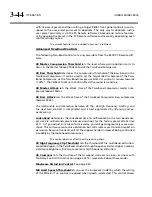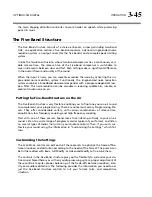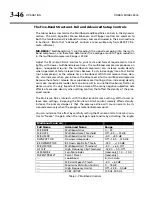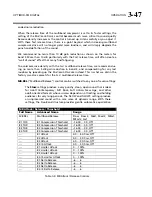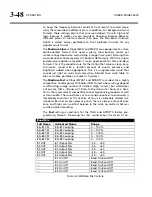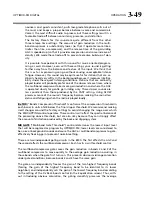
OPTIMOD-FM DIGITAL
OPERATION
3-37
never cause modulation to exceed 100%.
One of the essential differences between the
H
ARD
and
LLH
ARD
bass clip-
per modes is that switching between Hard and Med does not change de-
lay and is therefore less likely to cause audible clicks.
The
C
LIP
S
HAPE
control (in Advanced Control) offers further control over
the sound of the
H
ARD
and
LLH
ARD
modes. (See page 3-33.).
M
EDIUM
uses more sophisticated signal processing than
H
ARD
to reduce distortion
substantially.
S
OFT
uses the most sophisticated look-ahead signal processing to reduce distor-
tion further. Using
S
OFT
adds an additional 18 ms of delay to the processing (so
that the total is approximately 36 ms).
M
EDIUM
and
SOFT
are not available in Low Latency mode. The bass clipping is always
H
ARD
, but the
H
ARD
C
LIP
S
HAPE
control is still available to “soften” the clipping.
Advanced Clipper Controls
Overshoot Compensator Drive
sets the drive level into the overshoot compensa-
tor with reference to the final clip threshold, in units of dB. The normal setting is “0
dB.”
The overshoot compensator can produce audible distortion on material with strong
high frequency content (like bell trees), and this control lets you trade off this dis-
tortion against loudness. (Such material can cause strong overshoots, forcing the
overshoot compensator to work hard to eliminate them.) We do not recommend
operating this control above “0” because this would reduce the effectiveness of the
distortion cancellation used in earlier processing. However, you can reduce it below
“0” if you value the last bit of high frequency cleanliness over loudness.
The overshoot compensator works at 256 kHz sample rate and is fully anti-aliased.
The Two-Band Structure
The Two-Band structure consists of a slow two-band gated AGC (Automatic Gain
Control) for gain riding, followed by an equalization section, a gated two-band
compressor, a high-frequency limiter, and a complex peak limiting system similar to
the one used in the Five-Band structure. Like the “Two-Band Purist” structure in
Orban’s OPTIMOD-FM 8200, the 8300’s Two-Band Structure is phase-linear through-
out to maximize sonic transparency.
The Two-Band structure has an open, easy-to-listen-to sound that is similar to the
source material if the source material is of good quality. However, if the spectral
balance between the bass and high frequency energy of the program material is in-
correct, the Two-Band structure (when its
BAND
COUPLING
2>1
control is operated
toward 0%) can gently correct it without introducing obvious coloration.
Summary of Contents for 8300J
Page 1: ...Operating Manual OPTIMOD FM 8300 Digital Audio Processor Version 2 1 Software...
Page 7: ...Operating Manual OPTIMOD FM 8300 Digital Audio Processor Version 2 1 Software...
Page 24: ......
Page 94: ...2 46 INSTALLATION ORBAN MODEL 8300 This page intentionally left blank...
Page 190: ......
Page 204: ......
Page 246: ......
Page 247: ...OPTIMOD FM DIGITAL TECHNICAL DATA 6 29...
Page 254: ...6 36 TECHNICAL DATA ORBAN MODEL 8300 CPU Module...
Page 260: ...6 42 TECHNICAL DATA ORBAN MODEL 8300 8300 RS232 BOARD PARTS LOCATOR...
Page 262: ...6 44 TECHNICAL DATA ORBAN MODEL 8300 8300 POWER SUPPLY PARTS LOCATOR...
Page 264: ...6 46 TECHNICAL DATA ORBAN MODEL 8300 8300 I O BOARD PARTS LOCATOR...
Page 270: ...6 52 TECHNICAL DATA ORBAN MODEL 8300 DSP BOARD PARTS LOCATOR DRAWING 32170 000 14...
Page 278: ...6 60 TECHNICAL DATA ORBAN MODEL 8300 8300 DISPLAY BOARD PARTS LOCATOR...
Page 279: ...OPTIMOD FM DIGITAL TECHNICAL DATA 6 61 DISPLAY BOARD...














